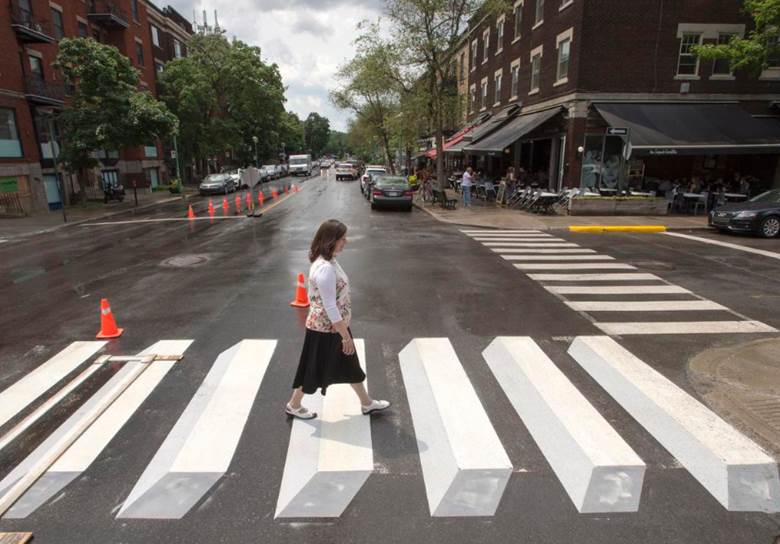
Montreal 3D crosswalk experiment messing with drivers’ minds to increase pedestrian safety
Thestar.com
July 11, 2018
Allan Woods

Add the Montreal neighbourhood of Outremont to a small global club experimenting with optical illusions to increase pedestrian safety.
On Tuesday of this week, at a busy intersection that includes a popular theatre and two bustling restaurants with patios, a crew arrived to repaint the crosswalk. But instead of simply freshening up the old white zebra crossing, they added new lines and shades of colour.
The painting style of a 3D crosswalk, such as this one in the Montreal borough of Outremont, creates an optical illusion that makes the lines appear to float above the ground.
The end result makes it look as though white rectangular blocks were somehow hovering in the air, at least from the angle of approaching drivers -- which is the only angle that counts for this particular pilot project.
The goal is that complacent drivers who might encroach on the crosswalk or be distracted by the crowds gathered on either side of the street are shocked into awareness and pressing down on the brakes by this three-dimensional illusion.
“In the last few years there had been budget cuts for ground markings, but our administration decided it was important to have good markings on the ground for the security of pedestrians,” explained Valerie Proteau, a neighbourhood councillor.
“We saw some creative ideas from Europe in this regard with respect to 3D that we thought would be interesting to test out in our arrondisement.”
The use of pavement illusions has been studied and tested for its effect on drivers and pedestrian safety for a number of years, although there are few definitive results available.
A 2012 Masters Thesis from Western Michigan University, “Effects of Symbol Prompts and 3D Pavement Illusions on Motorist Yielding at Crosswalks” compared driving habits at two crosswalks -- one with a pavement message that said “Look for Pedestrians” and another with a message and 3D illusions painted on the ground.
It found that the pavement message resulted in drivers who were more liable to yield for pedestrians. Adding the 3D illusions increased that behaviour, at least initially.
“Over time, the novelty of the 3D pavement illusions reduced motorist yielding back to the previous pavement message only condition,” wrote the study’s author, Nicole Cambridge.
It noted that a 2001 study in the Netherlands found 3D illusions in the roadway had no significant effect on drivers’ speeding habits, while a 2006 study in the United States found the opposite -- that drivers tended to lower their speed in the face of the optical illusions on the pavement.
There didn’t appear to be much driver hesitation at the Outremont intersection on Wednesday afternoon.
Sam Kahoul, who lives not far from the crosswalk, said after he had driven through the intersection and pulled over to let his father out of the car that though he had heard of the pilot project in the news, he didn’t notice it when he drove past.
He got out of his car to look at the intersection, but the illusion only really works from up close and in one direction.
“Oh, wow,” he said, when shown a photograph. “That’s nice. To be honest, I didn’t notice it because it’s something we take for granted. When it’s our daily life, our minds are programmed not to start thinking about it.”
He applauded the initiative, though he said the best option for cutting the speed of cars in his mind is speed bumps.
Another woman who crossed the street said she didn’t notice the illusion even as she walked over it. At first she thought it was simply brighter, which she said was a good thing. When shown a picture that revealed the optical trick, she soured on the change.
“That’s not good,” she said. “It’s going to scare the drivers.”
It’s unclear how Outremont will determine if the pilot project is successful.
The borough’s mayor, Philippe Thomlinson, wrote on Facebook that the trial will only be at this one intersection and only for one year.
“The ratio of price to effectiveness hasn’t really been proven,” he wrote. “We’re very aware of that.”
Proteau said the evaluation will be more qualitative than quantitative. The local administration will consult with residents and local merchants “to see if there is an increased feeling of safety for pedestriants and to see if drivers have gotten the message we’re sending to them to save place for pedestrians.”
